Prime Time NCERT Solutions | Mathematics for Class 6 PDF Download
| Table of contents |

|
| Page 108 |

|
| Page 109 |

|
| Page 110 & 111 |

|
| Page 113 |

|
| Page 114 |

|
| Page 115 |

|
| Page 116 |

|
| Page 120 |

|
| Page 122 |

|
| Page 123 |

|
| Page 124 |

|
| Page 125 |

|
| Page 126 |

|
Page 108
Figure it Out
Q1: At what number is ‘idli-vada’ said for the 10th time?
Ans: To determine the 10th occurrence of “idli- vada”; we need to identify the numbers that are multiples of both 3 and 5.
The numbers for which “idli-vada” is said are the multiples of 15.
This sequence is: 15,30,45,60, 75,90, 105, 120,135,150,…
Thus, the 10th number for which players should say “idli-vada” is 150.
OR
The number at which "Idli-vada" is said for the 10th time = 10 x 15 = 150.
Q2: If the game is played for the numbers 1 to 90, find out:
(a) How many times would the children say ‘idli’ (including the times they say ‘idli-vada’)?
Ans: The multiples of 3 from 1 till 90 are 3, 6, 9, 12,15,18, 21, 24, 27, 30, 33, 36, 39,42,45,48, 51, 54, 57, 60, 63, 66, 69, 72, 75, 78, 81, 84, 87 and 90.
Thus, the number of times the children would say ‘idli’ is 30.
OR
'Idli' is said for the numbers that are multiples of 3.
Number of times children would say 'idli' = 90 / 3
= 30 times.
(b) How many times would the children say ‘vada’ (including the times they say ‘idli-vada’)?
Ans: The multiples of 5 from 1 to 90 are 5, 10,15, 20, 25, 30, 35,40, 45, 50, 55,60, 65, 70, 75, 80, 85 and 90.
Thus, the number of times the children would say ‘vada’ is 18.
OR
'Vada' is said for the numbers that are multiples of 5.
Number of times children would say 'vada' = 90 / 5
= 18 times.
(c) How many times would the children say ‘idli-vada’?
Ans: The multiples of 15 are 15, 30,45,60, 75 and 90. Thus, the number of times the children would say ‘idli-vada’ is 6.
OR
'Idli-vada' is said for the numbers that are multiples of 15.
Number of times children would say 'idli-vada' = 90 / 15
= 6 times.
Q3: What if the game was played till 900? How would your answers change?
Ans: If the game is played till 900:
Times 'idli' is said (including 'idli-vada'):
There are 900/3 = 300 multiples of 3.
The multiples of 15 up to 900 are 900/15 = 60
Total times 'idli' is said: 300.
Times 'vada' is said (including 'idli-vada'):
There are 900/5 = 180 multiples of 5.
Subtract the 60 times 'idli-vada' is said.
Total times 'vada' is said: 180.
Times 'idli-vada' is said:
'Idli-vada' is said for multiples of 15, and there are 900/15 = 60 multiples of 15.
Total times 'idli-vada' is said: 60.
Q4: Is this figure somehow related to the ‘idli-vada’ game?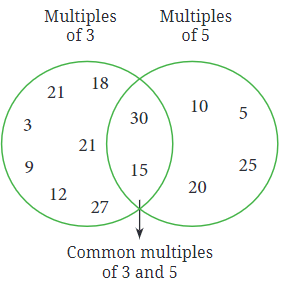
Ans: Yes, it is related to idli-vada game, if we assume 3 for idli and 5 for vada.
Multiples of 3: 3, 6, 9, 12, 15, 18, 21, 24, 27, 30, 33, 36, 39, 42, 45, 48, 51, 54, 57, 60.
Multiples of 5: 5, 10, 15, 20, 25, 30, 35, 40, 45, 50, 55, 60.
Multiples of 15: 15, 30, 45, 60.

Q: Let us now play the 'idli-vada' game with different pairs of numbers:
(a) 2 and 5,
(b) 3 and 7,
(c) 4 and 6.
We will say 'idli' for multiples Of the smaller number, 'vada' for multiples Of the larger number and 'idli-vada' for common multiples. Draw a figure similar to Figure 5.1 if the game is played up to 60.
Ans: (a) 2 and 5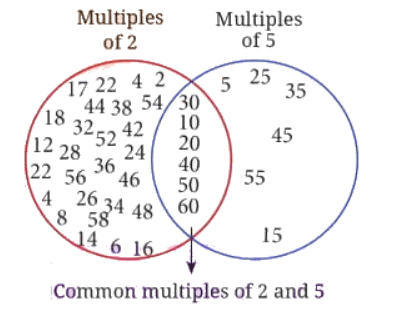
(b) 3 and 7 (c) 4 and 6
(c) 4 and 6
Page 109
Q: Which of the following could be the other number: 2, 3, 5, 8,10?
Ans: 2
Page 110 & 111
Q: What jump size can reach both 15 and 30? There are multiple jump sizes possible. Try to find them all.
Ans:
To find the jump sizes that allow Jumpy to land on both 15 and 30, you need to determine the common factors of these two numbers. Here’s how you can find these common jump sizes:
Factors of 15:
15 can be factored into: 15 = 3 × 5
The factors of 15 are: 1, 3, 5, 15
Factors of 30:
30 can be factored into: 30 = 2 × 3 × 5
The factors of 30 are: 1, 2, 3, 5, 6, 10, 15, 30
The common factors between these two lists are: 1, 3, 5, 15. So, the jump sizes that will allow Jumpy to land on both 15 and 30 are the common factors of 15 and 30.
Therefore, the jump sizes that will enable Jumpy to land on both 15 and 30 are: 1, 3, 5, 15
Q: Look at the table below. What do you notice? In the table,
In the table,
1. Is there anything common among the shaded numbers?
2. Is there anything common among the circled numbers?
3. Which numbers are both shaded and circled? What are these numbers called?
Ans: 1. The shaded numbers in the table are: 33, 36, 39, 42, 45, 48, 51, 54, 57, 60, 63, 66, 69. These are all multiples of 3. So, the numbers in shaded boxes are multiples of 3.
2. The circled numbers in the table are: 32, 36, 40, 44, 48, 52, 56, 60, 64, 68. These are all multiples of 4. So, the numbers in circles are multiples of 4.
3. The numbers that are both shaded and circled are: 36, 48, 60. These numbers are called common multiples of 12 (3 and 4 both).
Figure it Out
Q1: Find all multiples of 40 that lie between 310 and 410.
Ans: The multiples of 40 between 310 and 410 are: 320, 360, 400.
Explanation: Start by finding the smallest multiple of 40 greater than 310, which is 320. Then, keep adding 40 to find the next multiples until you reach or exceed 410.
Q2: Who am I?
(a) I am a number less than 40. One of my factors is 7. The sum of my digits is 8.
Ans: 7 is the common factors of 7, 14, 21,28, 35, which are less than 40. And there is one number which have digit sum of 8, is 35 = (3 + 5) = 8.
So, I am 35.

(b) I am a number less than 100. Two of my factors are 3 and 5. One of my digits is 1 more than the other.
Ans: Common factors of 3 and 5 are 15, 30, 45, 60, 75,90, (which are less than 100). And there is one number which one of digit is 1 more than the other that is 45. So, I am 45.
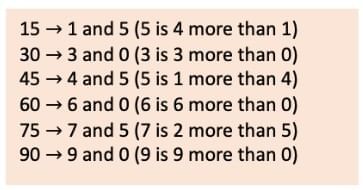
Q3: A number for which the sum of all its factors is equal to twice the number is called a perfect number. The number 28 is a perfect number. Its factors are 1, 2, 4, 7, 14, and 28. Their sum is 56 which is twice 28. Find a perfect number between 1 and 10.
Ans: The perfect number between 1 and 10 is 6. The factors of 6 are 1, 2, 3 and 6, and their sum is 12, which is twice 6.
- 1 is not twice 1. (1 is not a perfect number)
- Factors of 2 → 1, 2. Sum of factors = 1 + 2 = 3.
3 is not twice 2. (2 is not a perfect number) - Factors of 3 → 1, 3. Sum of factors = 1 + 3 = 4.
4 is not twice 3. (3 is not a perfect number) - Factors of 4 → 1, 2, 4. Sum of factors = 1 + 2 + 4 = 7.
7 is not twice 4. (4 is not a perfect number) - Factors of 5 → 1, 5. Sum of factors = 1 + 5 = 6.
6 is not twice 5. (5 is not a perfect number) - Factors of 6 → 1, 2, 3, 6. Sum of factors = 1 + 2 + 3 + 6 = 12.
12 is twice 6. (6 is a perfect number) - Factors of 7 → 1, 7. Sum of factors = 1 + 7 = 8.
8 is not twice 7. (7 is not a perfect number) - Factors of 8 → 1, 2, 4, 8. Sum of factors = 1 + 2 + 4 + 8 = 15.
15 is not twice 8. (8 is not a perfect number) - Factors of 9 → 1, 3, 9. Sum of factors = 1 + 3 + 9 = 13.
13 is not twice 9. (9 is not a perfect number) - Factors of 10 → 1, 2, 5, 10. Sum of factors = 1 + 2 + 5 + 10 = 18.
18 is not twice 10. (10 is not a perfect number)
Therefore, 6 is a perfect number between 1 and 10.
Q4: Find the common factors of:
(a) 20 and 28
Ans: 20 and 28: The common factors are 1, 2 and 4.
Explanation: The factors of 20 are 1, 2, 4, 5, 10, and 20. The factors of 28 are 1, 2, 4, 7, 14, and 28. The common factors are 1, 2, and 4.
(b) 35 and 50
Ans: The common factors of 35 and 50 are 1 and 5.
Explanation: The factors of 35 are 1, 5, 7, and 35. The factors of 50 are 1, 2, 5, 10, 25, and 50. The common factors are 1 and 5.
(c) 4, 8, and 12
Ans: The common factors of 4, 8, and 12 are 1, 2 and 4.
Explanation: The factors of 4 are 1, 2, and 4. The factors of 8 are 1, 2, 4, and 8. The factors of 12 are 1, 2, 3, 4, 6, and 12. The common factors are 1 and 2, 4.
(d) 5, 15, and 25
Ans: The common factors of 5, 15, and 25 are 1 and 5.
Explanation: The factors of 5 are 1 and 5. The factors of 15 are 1, 3, 5, and 15. The factors of 25 are 1, 5, and 25. The common factors are 1 and 5.
Q5: Find any three numbers that are multiples of 25 but not multiples of 50.
Ans: Three numbers that are multiples of 25 but not multiples of 50: 25, 75 and 125.
Q6: Anshu and his friends play the ‘idli-vada’ game with two numbers, which are both smaller than 10. The first time anybody says ‘idli-vada’ is after the number 50. What could the two numbers be which are assigned ‘idli’ and ‘vada’?
Ans: The two numbers could be 6 and 9, 7 and 8, 7 and 9, 8 and 9.
Explanation: Understanding the game: The phrase "idli-vada" is said when a number is a multiple of both assigned numbers.
Finding the Least Common Multiple (LCM): The first time "idli-vada" is said after 50 means the Least Common Multiple (LCM) of the two numbers is the first common multiple that is greater than 50.
Possible pairs: Since both numbers are smaller than 10, the pairs that satisfy the condition are:
6 and 9: The first common multiple after 50 is 54
(6 x 9 = 54, and 9 x 6 = 54).7 and 8: The first common multiple after 50 is 56
(7 x 8 = 56, and 8 x 7 = 56).7 and 9: The first common multiple after 50 is 63
(7 x 9 = 63, and 9 x 7 = 63).8 and 9: The first common multiple after 50 is 72
(8 x 9 = 72, and 9 x 8 = 72).
Q7: In the treasure hunting game, Grumpy has kept treasures on 28 and 70. What jump sizes will land on both the numbers?
Ans:
Factors of 28: 1, 2, 4, 7, 14, 28. (These jump sizes will land on 28)
Factors of 70: 1, 2, 5, 7, 10, 14, 35, 70. (These jump sizes will land on 70)
Common factors: 1, 2, 7, 14.
Therefore, 1, 2, 7 and 14 jump sizes will land on both numbers 28 and 70.
Q8: In the diagram below, Guna has erased all the numbers except the common multiples. Find out what those numbers could be and fill in the missing numbers in the empty regions.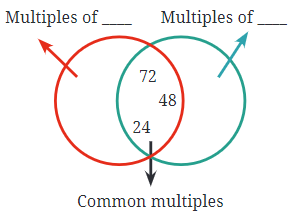 Ans: Common multiples—
Ans: Common multiples—
Left circle (Multiples of 12): 12, 24, 36, 48, 60, 72, etc.
Right circle (Multiples of 8): 8, 16, 24, 32, 40, 48, 56, 64, 72, etc.
So, the numbers in the red circle are multiples of 12 and the numbers in the blue circle are multiples of 8.
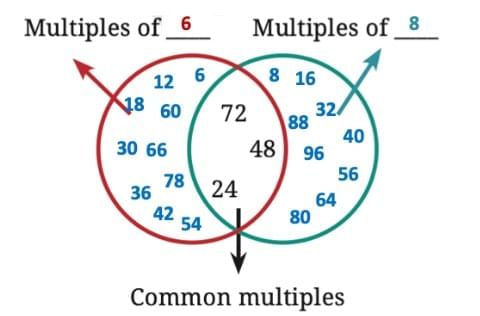
Explanation: In the Venn diagram, the numbers in the overlap (common multiples) are 24, 48, and 72. Therefore, the red circle could represent multiples of 24, and the blue circle could represent multiples of 48.
Q9: Find the smallest number that is a multiple of all the numbers from 1 to 10 except for 7.
Ans: To find the smallest number that is a multiple of all numbers from 1 to 10 except 7, we calculate the least common multiple of the numbers 1, 2, 3, 4, 5, 6, 8, 9 and 10. The least common multiple of these numbers is 360.
= 2 x 2 x 2 x 3 x 3 x 5 = 360.
Q10: Find the smallest number that is a multiple of all the numbers from 1 to 10.
Ans: To find the smallest number that is a multiple of all the numbers from 1 to 10, we calculate the smallest multiple of 1, 2, 3, 4, 5, 6, 7, 8, 9 and 10. The smallest multiple of these numbers is 2520.
The required smallest number = L.C.M of numbers 1, 2, 3, 4, 5, 7, 6, 8, 9, 10.
= 2 x 2 x 2 x 3 x 3 x 5 x 7
= 360 x 7 = 2520.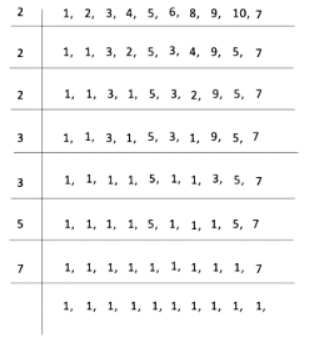
Page 113
Q: How many prime numbers are there from 21 to 30? How many composite numbers are there from 21 to 30?
Ans: Prime numbers are numbers that have only two divisors: 1 and the number itself. The prime numbers between 21 and 30 are: 23 and 29. So, there are 2 prime numbers.
Composite numbers are numbers that have more than two divisors. The composite numbers between 21 and 30 are: 22, 24, 25, 26, 27, 28 and 30. So, there are 7 composite numbers.
Page 114
Figure it Out
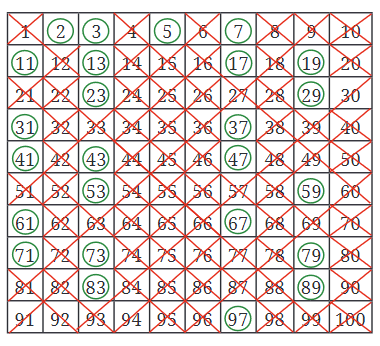 Q1: We see that 2 is a prime and also an even number. Is there any other even prime?
Q1: We see that 2 is a prime and also an even number. Is there any other even prime?
Ans: No, there is no other even prime number.
Explanation: The number 2 is the only even prime number because a prime number has exactly two distinct positive divisors: 1 and itself. Any other even number can be divided by 2, meaning it has at least three divisors (1, 2, and the number itself), so it cannot be prime.
Q2: Look at the list of primes till 100. What is the smallest difference between two successive primes? What is the largest difference?
Ans: To find the smallest difference between two successive prime numbers up to 100, let’s list the prime numbers in that range and calculate the differences between each pair: Prime numbers up to 100: 2, 3, 5, 7, 11, 13, 17, 19, 23, 29, 31, 37, 41, 43, 47, 53, 59, 61, 67, 71, 73, 79, 83, 89, 97
Differences between successive primes:
- 3 – 2 = 1
- 5 – 3 = 2
- 7 – 5 = 2
- 11 – 7 = 4
- 13 – 11 = 2
- 17 – 13 = 4
- 19 – 17 = 2
- 23 – 19 = 4
- 29 – 23 = 6
- 31 – 29 = 2
- 37 – 31 = 6
- 41 – 37 = 4
- 43 – 41 = 2
- 47 – 43 = 4
- 53 – 47 = 6
- 59 – 53 = 6
- 61 – 59 = 2
- 67 – 61 = 6
- 71 – 67 = 4
- 73 – 71 = 2
- 79 – 73 = 6
- 83 – 79 = 4
- 89 – 83 = 6
- 97 – 89 = 8
The smallest difference between two successive primes up to 100 is 1 (between the primes 2 and 3).
The largest difference between two successive primes up to 100 is 8, which occurs between the primes 89 and 97.
Q3: Are there an equal number of primes occurring in every row in the table on the previous page? Which decades have the least number of primes? Which have the most number of primes?
Ans: There is not an equal number of primes in every row. The number of primes varies between rows. The decade 90-99 has the least number of primes with only 1 prime (97).
The decades 0-9 and 10-19 have the greatest number of primes, each with 4 primes.
Q4: Which of the following numbers are prime? 23, 51, 37, 26
Ans:
Factors of 23: 1, 23.
Factors of 51: 1, 3, 17, 51.
Factors of 37: 1, 37.
Factors of 26: 1, 2, 13, 26.
Therefore, 23 and 37 are prime.
Q5: Write three pairs of prime numbers less than 20 whose sum is a multiple of 5.
Ans: Prime numbers less than 20: 2, 3, 5, 7, 11, 13, 17, 19.
2 + 3 = 5 (multiple of 5)
3 + 7 = 10 (multiple of 5)
7 + 13 = 20 (multiple of 5)
Therefore, the required three pairs of prime numbers are (2,3), (3,7) and (7,13).
Q6: The numbers 13 and 31 are prime numbers. Both these numbers have the same digits 1 and 3. Find such pairs of prime numbers up to 100.
Ans: Numbers with digits 1 and 3: 13, 31
Numbers with digits 1 and 7: (17, 71)
Numbers with digits 3 and 7: (37, 73)
Therefore, the required prime pairs are (13, 31); (17, 71) and (37, 73)..
Q7: Find seven consecutive composite numbers between 1 and 100.
Ans: Seven consecutive composite numbers between 1 and 100 are 90, 91, 92, 93, 94, 95, and 96.
Explanation: A composite number has more than two factors. The numbers 90 through 96 are all composite and occur consecutively.
Q8: Twin primes are pairs of primes having a difference of 2. For example, 3 and 5 are twin primes. So are 17 and 19. Find the other twin primes between 1 and 100.
Ans: The twin primes between 1 and 100 are (3, 5), (5, 7), (11, 13), (17, 19), (29, 31), (41, 43), (59, 61), and (71, 73).
Explanation: Twin primes are pairs of prime numbers that differ by exactly 2, and these are all the pairs between 1 and 100.
Page 115
Q9: Identify whether each statement is true or false. Explain.
(a) There is no prime number whose units digit is 4.
Ans: True.
Explanation: A prime number must end in 1, 3, 7, or 9 (except for the number 2) because any number ending in 0, 2, 4, 6, or 8 is divisible by 2.
(b) A product of primes can also be prime.
Ans: False.
Explanation: A product of two or more prime numbers results in a composite number, not a prime.
(c) Prime numbers do not have any factors.
Ans: False.
Explanation: Prime numbers have exactly two factors: 1 and the number itself.
(d) All even numbers are composite numbers.
Ans: False.
Explanation: The number 2 is an even number, but it is also a prime number.
(e) 2 is a prime and so is the next number, 3. For every other prime, the next number is composite.
Ans: True.
Explanation: After 2 and 3, the next number after any prime is composite because it is divisible by at least two numbers (1 and the prime itself).
Q10: Which of the following numbers is the product of exactly three distinct prime numbers: 45, 60, 91, 105, 330?
Ans: Number 105 is the product of exactly three distinct prime numbers i.e. 3 × 5 × 7.
Explanation:
- 60 = 2 × 3 × 5 (three distinct primes)
- 105 = 3 × 5 × 7 (three distinct primes)
- 330 = 2 × 3 × 5 × 11 (four distinct primes, so it doesn't count)
- 91 = 7 × 13 (two distinct primes)
- 45 = 3 × 3 × 5 (two distinct primes)
Q11: How many three-digit prime numbers can you make using each of 2, 4, and 5 once?
Ans: Numbers formed by using digits 2, 4 and 5 once: 245, 254, 425, 452, 524, 542.
245(divisible by 5) — Not prime
254(divisible by 2) — Not prime
425(divisible by 5) — Not prime
452(divisible by 2) — Not prime
524(divisible by 2) — Not prime
542(divisible by 2) — Not prime
Therefore, there are no three-digit prime numbers that can be made using digits 2, 4 and 5 once.
Q12: Observe that 3 is a prime number, and 2 × 3 + 1 = 7 is also a prime. Are there other primes for which doubling and adding 1 gives another prime? Find at least five such examples.
Ans: The five prime numbers for which doubling and adding 1 gives another prime are:
- 2 (since 2 × 2 + 1 = 5)
- 3 (since 2 × 3 + 1 = 7)
- 5 (since 2 × 5 + 1 = 11)
- 11 (since 2 × 11 + 1 = 23)
- 23 (since 2 × 23 + 1 = 47)
Q: Where should Grumpy place the treasures so that Jumpy cannot reach both the treasures?
Ans: In order to prevent Jumpy from reaching both treasures, Grumpy should place the treasures on two numbers that do not share any common factors (Other than 1). These numbers are called co-prime.
For example: Grumpy could place the treasures on 4 and 9, as they are co-prime (they don't have any common factors except 1). This would mean that Jumpy cannot reach both numbers with a single jump size, except for a jump size of 1, which is not allowed by the game rules. This strategy ensures that Jumpy will not be able to land on both numbers using any jump size other than 1.
Page 116
Q: Which of the following pairs of numbers are co-prime?
(a) 18 and 35
Ans: Here factors of 18 = 1 × 2 × 3 × 3 and factors of 35 = 1 × 5 × 7
No common factor other than 1.
Hence 18 and 35 are co-prime numbers.
(b) 15 and 37
Ans: We have factors of 15 = 1 × 3 × 5 and factors of 37 = 1 × 37
No common factor other than 1.
Hence 15 and 37 are co-prime numbers.
(c) 30 and 415
Ans: Given numbers are 30 and 415 Here factors of 30 = 1 × 2 × 3 × 5 and factors of 415 = 5 × 83
Clearly 5 is a common factor of 30 and 415.
Hence 30 and 415 are not co-prime numbers.
(d) 17 and 69
Ans: Factors of 17 = 1, 17
Factors of 69 = 1, 3, 23, 69
Common factor = 1
Hence, 17 and 69 are co-prime.
(e) 81 and 18
Ans: Factors of 81: 1, 3, 9, 27,81 and
Factors of 18: 1, 2, 3, 6, 9, 18
Common factors: 1, 3, 9
Co-prime: No (They share common factors of 3 and 9)
Final Result:
- 18 and 35: Co-prime
- 15 and 37: Co-prime
- 30 and 415: Not co-prime
- 17 and 69: Co-prime
- 81 and 18: Not co-prime
Q: While playing the 'idli-vada' game with different number pairs, Anshu observed something interesting!
(a) Sometimes the first common multiple was the same as the product of the two numbers.
(b) At other times the first common multiple was less than the product of the two numbers.
Find examples for each of the above. How is it related to the number pair being co-prime?
Ans: (a) Sometimes the first common multiple was the same as the product of the two numbers. This happens when the two numbers are co-pr'ime, meaning they have no common factors other than 1.
For example: Consider the pair 3 and 5.
The product of 3 and 5 is 3 x 5 = 15.
The least common multiple (LCM) of 3 and 5 is also 15.
Since 3 and 5 are co-prime, their LCM is equal to their product.
(b) The first common multiple less than the product Of the two numbers: This occurs when the two numbers are not co-prime (they share a common factor greater than 1). In such cases, the LCM is less than the product of the two numbers.
For example: Consider the pair 4 and 6.
The product of 4 and 6 is 4 x 6 = 24.
The LCM of 4 and 6 is 12 (not 24) because they share a common factor (2).
Since 4 and 6 are not co-prime, the LCM is less than their product.
Relation to Co-Prime Numbers
- Co-prime numbers: When two numbers are co-prime (like 3 and 5), their LCM is the product of the two numbers because they do not share any common factors.
- Non co-prime numbers: When two numbers are not co-prime (like 4 and 6), their LCM is less than their product because the common factor allows for a smaller multiple. So, if the numbers are co-prime, their LCM equals the product. If they are not co-prime, their LCM is less than the product.
Q: Observe the following thread art. The first diagram has 12 pegs and the thread is tied to every fourth peg (we say that the thread-gap is 4). The second diagram has 13 pegs and the thread-gap is 3. What about the other diagrams? Observe these pictures, share and discuss your findings in class.
In some diagrams, the thread is tied to every peg. In some, it is not. Is it related to the two numbers (the number of pegs and the thread-gap) being co-prime?
(a) 15 pegs, thread-gap of 10
(b) 10 pegs, thread-gap of 7
(c) 14 pegs, thread-gap of 6
(d) 8 pegs, thread-gap of 3
Ans: Third diagram: 16 pegs with a thread-gap of 6.
Fourth diagram: 24 pegs with a thread-gap of 6.
(a) 15 pegs, thread-gap of 10: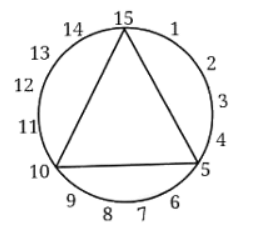 (b) 10 pegs, thread-gap of 7:
(b) 10 pegs, thread-gap of 7: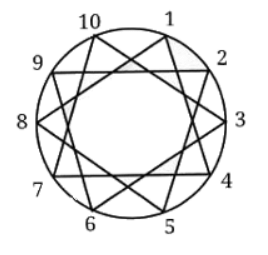
(c) 14 pegs, thread-gap of 6:
(d) 8 pegs, thread-gap of 3: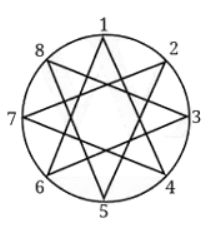
Page 120
Figure it Out
Q1: Find the prime factorisations of the following numbers: 64, 104, 105, 243, 320, 141, 1728, 729, 1024, 1331, 1000.
Ans:
(i) The prime factorization of 64 is 2 × 2 × 2 × 2 × 2 × 2.
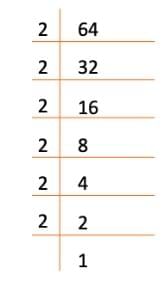
(ii) The prime factorization of 104 is 2 × 2 × 2 × 13.
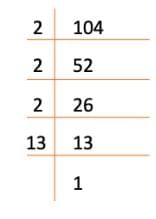
(iii) The prime factorization of 105 is 3 × 5 × 7.

(iv) The prime factorization of 243 is 3 × 3 × 3 × 3 × 3.
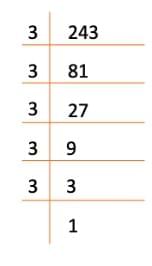
(v) The prime factorization of 320 is 2 × 2 × 2 × 2 × 2 × 2 × 5.
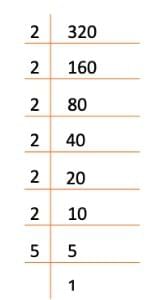
(vi) The prime factorization of 141 is 3 × 47.
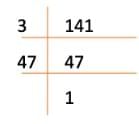
(vii) The prime factorization of 1728 is 2 × 2 × 2 × 2 × 2 × 2 × 3 × 3 × 3.

(viii)The prime factorization of 729 is 3 × 3 × 3 × 3 × 3 × 3.
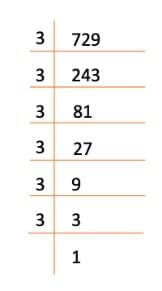
(ix) The prime factorization of 1024 is 2 × 2 × 2 × 2 × 2 × 2 × 2 × 2 × 2 × 2.
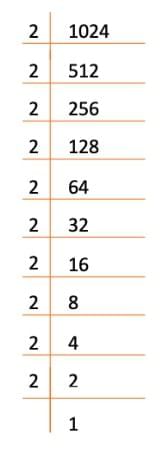
(x) The prime factorization of 1331 is 11 × 11 × 11.
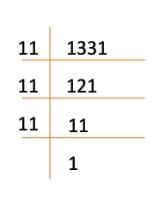
(xi) The prime factorization of 1000 is 2 × 2 × 2 × 5 × 5 × 5.
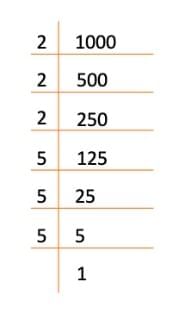
Q2: The prime factorisation of a number has one 2, two 3s, and one 11. What is the number?
Ans: The number is 198.
Explanation: The number is calculated as 2 × 3 × 3 × 11 = 198.
Q3: Find three prime numbers, all less than 30, whose product is 1955.
Ans: The prime factorisation of 1955:
1955 = 5 × 17 × 23
All the factors are prime numbers and are less than 30.
Hence, the three prime numbers whose product is 1955 are 5, 17, and 23.
Q4: Find the prime factorisation of these numbers without multiplying first:
(a) 56 × 25
Ans: Prime factors of 56 = 2 × 2 × 2 × 7
Prime factors of 25 = 5 × 5
Combined prime factorization of 56 × 25 = 2 × 2 × 2 × 7 × 5 × 5
(b) 108 × 75
Ans: Prime factors of 108 = 2 × 2× 3 × 3 × 3
Prime factors of 75 = 3 × 5 × 5
Combined prime factorization of
108 × 75 = 2 × 2 × 3 × 3 × 3 × 3 × 5 × 5
(c) 1000 × 81
Ans: Prime factors of 1000 = 2 × 2 × 2 × 5 × 5 × 5
Prime factors of 81 = 3 × 3 × 3 × 3
Combined prime factorization of 1000 × 81 = 2 × 2 × 2 × 5 × 5 × 5 × 3 ×3 × 3 × 3
Q5: What is the smallest number whose prime factorisation has:
(a) three different prime numbers?
Ans: The smallest prime numbers are 2, 3, and 5. To find the smallest number with these primes as factors, multiply them together:
2 × 3 × 5 = 30
So, the smallest number whose prime factorization has three different prime numbers is 30.
(b) four different prime numbers?
Ans: The smallest four prime numbers are 2, 3, 5, and 7. To find the smallest number with these primes as factors, multiply them together:
2 × 3 × 5 × 7 = 210
Thus, the smallest number whose prime factorization has four different prime numbers is 210.
Page 122
Figure it Out
Q1: Are the following pairs of numbers co-prime? Guess first and then use prime factorisation to verify your answer.
(a) 30 and 45
Ans: No, 30 and 45 are not co-prime.
Explanation: The prime factorization of 30 is 2 × 3 × 5, and the prime factorization of 45 is 3 × 3 × 5. They share common prime factors (3 and 5), so they are not co-prime.
(b) 57 and 85
Ans: Yes, 57 and 85 are co-prime.
Explanation: The prime factorization of 57 is 3 × 19, and the prime factorization of 85 is 5 × 17. They have no common prime factors, so they are co-prime.
(c) 121 and 1331
Ans: No, 121 and 1331 are not co-prime.
Explanation: The prime factorization of 121 is 11 × 11, and the prime factorization of 1331 is 11 × 11 × 11. They share the common prime factor 11, so they are not co-prime.
(d) 343 and 216
Ans: Yes, 343 and 216 are co-prime.
Explanation: The prime factorization of 343 is 7 × 7 × 7, and the prime factorization of 216 is 2 × 2 × 2 × 3 × 3 × 3. They have no common prime factors, so they are co-prime.
Q2: Is the first number divisible by the second? Use prime factorisation.
(a) 225 and 27
Ans: No, 225 is not divisible by 27.
Explanation: The prime factorization of 225 is 3 × 3 × 5 × 5, and the prime factorization of 27 is 3 × 3 × 3. Since 225 has only two 3s, it cannot be divisible by 27, which requires three 3s.
(b) 96 and 24
Ans: Yes, 96 is divisible by 24.
Explanation: The prime factorization of 96 is 2 × 2 × 2 × 2 × 2 × 3, and the prime factorization of 24 is 2 × 2 × 2 × 3. Since 96 has all the factors of 24, it is divisible by 24.
(c) 343 and 17
Ans: No, 343 is not divisible by 17.
Explanation: The prime factorization of 343 is 7 × 7 × 7, and 17 is a prime number with no common factors with 343, so it is not divisible by 17.
(d) 999 and 99
Ans: No, 999 is divisible by 99.
Explanation: The prime factorization of 999 is 3 × 3 × 3 × 37, and the prime factorization of 99 is 3 × 3 × 11. They do not share all factors, and 37 is not divisible by 11. So, 999 is not divisible by 99.
Q3: The first number has prime factorisation 2 × 3 × 7 and the second number has prime factorisation 3 × 7 × 11. Are they co-prime? Does one of them divide the other?
Ans: Prime factors Of first number = 2 x 3 x 7
Prime factors of second number = 3 x 7 x 11
The two numbers are not co-prime because they have 3 and 7 as common factors.
The first number is missing the prime factor 11 and the second number is missing the prime number 2.
Therefore, none of them divides the other.
Q4: Guna says, “Any two prime numbers are co-prime.” Is he right?
Ans: Yes, Guna is right.
Explanation: Any two distinct prime numbers have no common factors other than 1, which means they are always co-prime.
Page 123
Q: Consider this statement:
Numbers that are divisible by 10 are those that end with Do you agree?
Ans: Yes, I agree. Numbers that are divisible by 10 always end with a '0'. This is because 10 is a multiple of both 2 and 5, and for a number to be divisible by 10, it must have both 2 and 5 as factors. When a number ends in 0, it indicates that the number can be divided by 10 without leaving a remainder.
For example: 20, 30, 100 and 150 all end in 0 and they are divisible by 10.
Q: Consider this statement:
Numbers that are divisible by 5 are those that end with either a '0' or a '5'. Do you agree?
Ans: Yes, I agree. Numbers that are divisible by 5 always end with either '0' or '5'. This is because the divisibility rule for 5 states that a number must have 5 as one of its factors. For this to happen, the last digit of the number must be either 0 or 5.
For example: Numbers like 15, 25, 40 and 55 are all divisible by 5 because they end in 5 or 0.
Page 124
Q: Consider this statement:
Numbers that are divisible by 2 are those that end with '0', '2', '4, '6' or '8'. Do you agree?
What are all the multiples of 2 between 399 and 411?
Ans: Yes, I agree. Numbers that are divisible by 2 are those that end with '0', '2', '4', '6' or '8'
This is because for a number to be divisible by 2, it must be an even number, and all even numbers end in these digits.
Multiples of 2 between 399 and 411: 400, 402, 404, 406, 408 and 410.
These numbers end in 0, 2, 4, 6 or 8, confirming that they are divisible by 2.
Q: Find numbers between 330 and 340 that are divisible by 4. Also, find numbers between 1730 and 1740, and 2030 and 2040, that are divisible by 4. What do you observe?
Ans: The numbers between 330 and 340 that are divisible by 4 are 332, 336, and 340. The numbers between 1730 and 1740 that are divisible by 4 are 1732, 1736, and 1740. The numbers between 2030 and 2040 that are divisible by 4 are 2032, 2036, and 2040.
Q: Is 8536 divisible by 4?
Ans: Since the last two digits of 8536 (which is 36) are divisible by 4, the original number 8536 is also divisible by 4.
Q: Consider these statements:
(a) Only the last two digits matter when deciding if a given number is divisible by 4.
(b) If the number formed by the last two digits is divisible by 4, then the original number is divisible by 4.
(c) If the original number is divisible by 4, then the number formed by the last two digits is divisible by 4.
Do you agree? Why or why not?
Ans: (a) Yes, that’s correct. When determining if a number is divisible by 4, only the last two digits of the number matter. This is because 100 is divisible by 4, so the divisibility rule for 4 focuses on whether the number formed by the last two digits is divisible by 4.
(b) Yes, that’s correct. If the number formed by the last two digits of a given number is divisible by 4, then the original number is also divisible by 4.
(c) Yes, that’s correct. If the original number is divisible by 4, the last two digits of the number will indeed be divisible by 4.
Page 125
Q: Find numbers between 120 and 140 that are divisible by 8. Also find numbers between 1120 and 1140, and 3120 and 3140, that are divisible by 8. What do you observe?
Ans: Numbers divisible by 8:
Between 120 and 140: 120, 128 and 136.
Between 1120 and 1140: 1120, 1128 and 1136.
Between 3120 and 3140: 3120, 3128 and 3136.
Observation: The numbers divisible by 8 follow the same pattern across different ranges, spaced by 8.
Q: Change the last two digits of 8560 so that the resulting number is a multiple of 8.
Ans: The last two digits of 8560 are "60", which is not divisible by 8. Changing the last two digits to "64" makes it divisible by 8.
The new number is 8564, which is a multiple of 8.
Q: Consider this statement:
(a) Only the last three digits matter when deciding if a given number is divisible by 8.
(b) If the number formed by the last three digits is divisible by 8, then the original number is divisible by 8.
(c) If the original number is divisible by 8, then the number formed by the last three digits is divisible by 8.
Do you agree? Why or why not?
Ans: (a) False. Because only the last two digits matter when checking for divisibility by 8, as we are dealing with powers of 2.
(b) True. Because if the last three digits are divisible by 8, the whole number is divisible by 8.
(c) True. Because if the entire number is divisible by 8, its last three digits will also be divisible by 8.
Figure it Out
Q1: 2024 is a leap year (as February has 29 days). Leap years occur in the years that are multiples of 4, except for those years that are evenly divisible by 100 but not 400.
(a) From the year you were born till now, which years were leap years?
Ans: From the year 2010 till 2024, there are 4 leap years. 2012, 2016, 2020 and 2024.
(b) From the year 2024 till 2099, how many leap years are there?
Ans: The leap years from 2024 and 2099 are: 2024, 2028, 2032, 2036, 2040, 2044, 2048, 2052, 2056, 2060, 2064, 2068, 2072, 2076,, 2080, 2084, 2088, 2092, 2096.
Hence, there are 19 leap years from 2024 till 2099.
Q2: Find the largest and smallest 4-digit numbers that are divisible by 4 and are also palindromes.
Ans: Largest 4-digit number divisible by 4 and is also palindrome- 8888
Smallest 4-digit number divisible by 4 and is also palindrome- 2112.
Q3: Explore and find out if each statement is always true, sometimes true, or never true. You can give examples to support your reasoning.
(a) Sum of two even numbers gives a multiple of 4.
Ans: Sometimes true. Sum of any two even numbers is not always divisible by 4. For e×ample, 6 + 4 = 10 which is not divisible by 4 whereas 2+2 = 4 which is divisible of 4.
(b) Sum of two odd numbers gives a multiple of 4.
Ans: Sometimes true. Sum of two odd numbers can indeed be even but not necessarily a multiple of 4. For e×ample, 1 + 5 = 6 which is not a multiple of 4 whereas 1+3 = 4, which is a multiple of 4. Similarly 7 + 5 = 12, which is a multiple of 4.
Page 126
Q4: Find the remainders obtained when each of the following numbers are divided by i) 10, ii) 5, iii) 2.
78, 99, 173, 572, 980, 1111, 2345.
Ans:
(i) 78
Divided by 10: Remainder = 8
Divided by 5: Remainder = 3
Divided by 2: Remainder = 0
(ii) 99
Divided by 10: Remainder = 9
Divided by 5: Remainder = 4
Divided by 2: Remainder = 1
(iii) 173
Divided by 10: Remainder = 3
Divided by 5: Remainder = 3
Divided by 2: Remainder = 1
(iv) 572
Divided by 10: Remainder = 2
Divided by 5: Remainder = 2
Divided by 2: Remainder = O
(v) 980
Divided by 10: Remainder = O
Divided by 5: Remainder = O
Divided by 2: Remainder = O
(vi) 1111
Divided by 10: Remainder = 1
Divided by 5: Remainder = 1
Divided by 2: Remainder = 1
(vii) 2345
Divided by 10: Remainder = 5
Divided by 5: Remainder = 0
Divided by 2: Remainder = 1
Q5: The teacher asked if 14560 is divisible by all of 2, 4, 5, 8, and 10. Guna checked for divisibility of 14560 by only two of these numbers and then declared that it was also divisible by all of them. What could those two numbers be?
Ans: Divisibility of 14560 by 2, 4, 5, 8 and 10:
The two key numbers to check would be 4 and 5.
If a number is divisible by 4 and 5, it must also be divisible by 2, 8 and 10.
Q6: Which of the following numbers are divisible by all of 2, 4, 5, 8, and 10: 572, 2352, 5600, 6000, 77622160?
Ans: Divisible by 2, 4, 5, 8 and 10: 5600, 6000 and 77622160.
(i) 572
Ends in 2 : Divisible by 2.
Last two digits are 72 : divisible by 4.
Doesn't end in 0 or 5 : Not divisible by 5.
Last three digits are 572 : Not divisible by 8.
Doesn't end in 0 : Not divisible by 10.
(ii) 2352
Ends in 2 : Divisible by 2.
Last two digits are 52 : Divisible by 4.
Doesn't end in 0 or 5 : Not divisible by 5.
Last three digits are 352 : Divisible by 8.
Doesn't end in 0 : Not divisible by 10.
(iii) 5600
Ends in 0 : Divisible by 2.
Last two digits are 00 : Divisible by 4.
Ends in 0 : Divisible by 5.
Last three digits are 600 : Divisible by 8.
Ends in 0 : Divisible by 10.
(iv) 6000
Ends in 0 : Divisible by 2.
Last two digits are 00 : Divisible by 4.
Ends in 0 : Divisible by 5.
Last three digits are 000 : Divisible by 8.
Ends in 0 : Divisible by 10.
(v) 77622160
Ends in 0 : Divisible by 2.
Last two digits are 60 : Divisible by 4.
Ends in 0 : Divisible by 5.
Last three digits are 160 : Divisible by 8.
Ends in 0 : Divisible by 10.
Explanation: These numbers are divisible by all the factors because they meet the conditions of divisibility by 2, 4, 5, 8 and 10.
Q7: Write two numbers whose product is 10000. The two numbers should not have 0 as the units digit.
Ans: Prime factors of 1000 = 2×2×2×2×5×5×5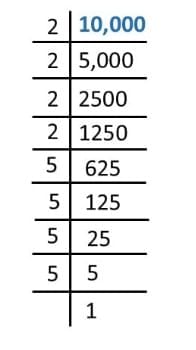
= (2×2×2×2)×(5×5×5×5)
= 16 × 625
Therefore, 16 and 625 are the two numbers that do not have '0' as the unit's digits and multiply together to form 1000.
|
48 videos|334 docs|23 tests
|
FAQs on Prime Time NCERT Solutions - Mathematics for Class 6
| 1. What are the main topics covered in the NCERT Class 6 Prime Time textbook? |  |
| 2. How can I effectively prepare for the Class 6 exams using the NCERT Prime Time solutions? |  |
| 3. Are NCERT solutions helpful for understanding difficult concepts in Class 6? |  |
| 4. Where can I find additional resources to supplement my learning from the NCERT Prime Time textbook? |  |
| 5. How often should I practice sample questions from the NCERT Prime Time to prepare for exams? |  |
















